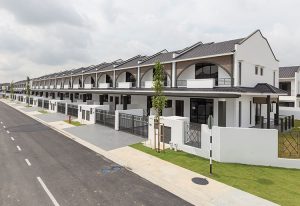Ringgit Malaysian (RM) 3.8 billion worth of unsold properties amounting to 5,988 units are found in the Malaysia state of Johor. The Star newspaper which reported this figure quoted the State Housing and Rural Development Committee chairman saying: “Based on statistics, there is a mismatch between demand and supply, especially with developers trying to make the most profits by building more high-end properties.”
The Committee chairman Dzulkefly Ahmad added that that the type of unsold properties include service apartments and properties valued between RM500,000 and RM1 million.
The Committee Chairman said that the housing market in Johor “has to be reformed” to enable up to 100,000 affordable homes to be built by 2023. “We need to reform in terms of building, distribution, financing and reducing building costs. There are weaknesses which can be manipulated by unscrupulous developers,” he said. He added, “so far, some 134,195 affordable homes were yet to be built by developers”.
The Johor chapter of the Real Estate and Housing Developers Association Malaysia (REHDA) in a recent report called for a faster mechanism to release unsold bumiputera quota houses to enable developers to help the state government build 100,000 affordable homes by 2023.
In a joint statement by its committee members, Johor REHDA said there was a need for “a clear and easy implementation checklist” for the release of unsold properties with bumiputera quota.
It said this stock of unsold properties “is not beneficial to the government nor developers. It is crucial that these unsold units be released and open for sale to generate income to the government in terms of tax revenue, quit rent and assessment, as well as to allow ownership for those in need of a home.”


Earlier this year, a market research analyst dismissed the view that Singapore buyers are the reason for the Johor Bahru property price escalation. Khor Yu Leng, the Southeast Asia Research Director of Segi Enam Advisors Pte Ltd said that there was very little and inconsistent data to support this belief. He added that as far as the Malaysian property market was concerned, property investors from China eclipsed buyers from Singapore.
According to another survey of Johor residents by the ISEAS-Yusof Ishak Institute, about 40 per cent of Malaysians blamed Singaporeans for the higher cost of living there. And an even higher number – 70 per cent – believed that Singaporeans make property unaffordable for locals b contributing to Johor Bahru property price escalation.
https://www.icompareloan.com/resources/eco-world-launch-large-houses-selangor/
But Khor, quoting data from the Malaysia My Second Home (MM2H) programme, said it was too simplistic to blame Singaporeans for this as the “data and a wider reading of the issue suggests strong domestic forces at play”.
The MM2H programme showed that about 3,200 applications from foreigners are accepted each year, but that Singaporeans are not the foreigners buying the most properties in Malaysia. Of the total number of buyers by nationalities over a 15-year period leading to August 2017, Singapore property buyers made up just 3.8 per cent of the total.
“Assuming each buys their own place, only around 1.1% of new housing and commercial units across Malaysia each year are sold to foreigners seeking a residency permit,” Khor said.
He added, “most who have signed onto the programme come from China (28%), Japan (12%), Bangladesh (11%), the UK (7%), and Korea (4%).”
Aggregating statistics from MM2H and Malaysia’s Inland Revenue Board, Khor believes that only 0.85 per cent of property sales in Malaysia are to foreigners.
“Of course, there would be Singapore and other foreign buyers who invest in Malaysian property while not seeking to apply for MM2H status. So it is surprising to find that the Inland Revenue Board’s (IRB) stamp duties system reports a ratio of 0.3% to 0.7% sold to foreigners each year in recent years. Averaging MM2H and IRB data, about 0.85% of property sales in Malaysia are to foreigners.”
Khor said while Johor seemed to have drawn disproportionate foreign buyer interest with 10.8 per cent of Johor properties sold to foreigners in recent years, the Penang Institute concluded that “Chinese investments in southern Johor have split the property development into a high-end market with excess supply targeted at foreigners as buyers, and a lower-tier market driven by local developers targeting mostly local buyers”.
Khor also quoted Bank Negara Malaysia’s report which said that average Malaysian house prices had increased faster than average incomes since the global financial crisis. While Johor had seen a property boom, with per square foot prices in some enclaves reaching Kuala Lumpur city centre price-levels.
https://www.icompareloan.com/resources/london-hold-sway-singapore-investors/
Khor noted that since 2017, Johor had witnessed a major slowdown with unsold properties – with a marked drop in transaction volume and property value.
This debunks the theory that Singapore buyers are the major reason for Johor Bahru property price escalation. This figure for the city of Johor Bahru is higher than Bank Negara Malaysia’s reported 2014 median house prices in Malaysia which were 4.4 times the median annual income.
But in comparison, other Malaysian cities like Kuala Lumpur and cities in Selangor (like Shah Alam, Subang Jaya, Petaling Jaya), have higher median house prices at 6.0 times-plus. George Town in Penang was the worst, with prices at 10.4 times median house prices in Malaysia.
Khor said Johor residents were reasonably insulated from the property enclave “boom-glut dynamics targeted at foreigners”. “Overall, the data suggests that the impact of foreign buyers is somewhat contained,” he added.
If you are thinking of investing in a property in Johor Bahru (or any other city in Malaysia), it would be useful to talk to your property agent or Financial Advisor to generate an investment analysis report for you which is available at www.iCompareLoan.com/consultant.

